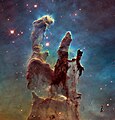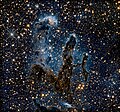پرونده:Eagle Nebula - GPN-2000-000987.jpg

اندازهٔ این پیشنمایش: ۶۰۶ × ۶۰۰ پیکسل. کیفیتهای دیگر: ۲۴۲ × ۲۴۰ پیکسل | ۴۸۵ × ۴۸۰ پیکسل | ۷۷۶ × ۷۶۸ پیکسل | ۱٬۰۳۵ × ۱٬۰۲۴ پیکسل | ۱٬۹۴۴ × ۱٬۹۲۴ پیکسل.
پروندهٔ اصلی (۱٬۹۴۴ × ۱٬۹۲۴ پیکسل، اندازهٔ پرونده: ۱٫۱۸ مگابایت، نوع MIME پرونده: image/jpeg)
تاریخچهٔ پرونده
روی تاریخ/زمانها کلیک کنید تا نسخهٔ مربوط به آن هنگام را ببینید.
| تاریخ/زمان | بندانگشتی | ابعاد | کاربر | توضیح | |
|---|---|---|---|---|---|
| کنونی | ۳ اکتبر ۲۰۱۲، ساعت ۰۰:۳۰ |  | ۱٬۹۴۴ در ۱٬۹۲۴ (۱٫۱۸ مگابایت) | Ras67 | losslessly cropped with Jpegcrop |
| ۹ آوریل ۲۰۰۹، ساعت ۰۱:۱۷ |  | ۱٬۹۹۳ در ۱٬۹۷۳ (۱٫۴۵ مگابایت) | BotMultichillT | {{Information |Description={{en|1=These eerie, dark pillar-like structures are columns of cool interstellar hydrogen gas and dust that are also incubators for new stars. The pillars protrude from the interior wall of a dark molecular cloud like stalagmite |
کاربرد پرونده
صفحههای زیر از این تصویر استفاده میکنند:
کاربرد سراسری پرونده
ویکیهای دیگر زیر از این پرونده استفاده میکنند:
- کاربرد در ar.wikipedia.org
- کاربرد در arz.wikipedia.org
- کاربرد در en.wikipedia.org
- کاربرد در eu.wikipedia.org
- کاربرد در hu.wikipedia.org
- کاربرد در ka.wikipedia.org
- کاربرد در kw.wikipedia.org
- کاربرد در zh.wikipedia.org






